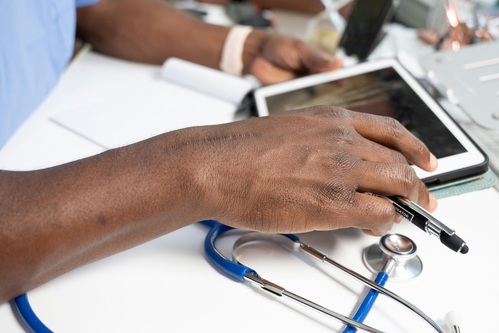The Importance of Secure and HIPAA-Compliant Faxing in Healthcare

In the healthcare industry, securing patient information is paramount. With sensitive data constantly exchanged between providers, ensuring confidentiality and compliance with regulations like HIPAA is a priority. Faxing, despite being a traditional method of communication, remains a reliable tool in healthcare settings. Below, we will explore how HIPAA-compliant faxing safeguards patient privacy, mitigates data risks, and highlights best practices for secure fax solutions. Keep reading to understand how these measures contribute to a safer healthcare environment.
How Secure Faxing Mitigates Healthcare Data Risks
Alt text: A medical professional using secure healthcare fax to mitigate healthcare data risks
Healthcare data is an attractive target for cybercriminals due to its high value and sensitivity. When properly secured, faxing mitigates the risk of data breaches by offering a reliable method of transmission. Unlike email, which can be vulnerable to hacking, faxing provides a direct, encrypted line that reduces the risk of interception during transmission.
Data loss can occur if healthcare fax systems are not adequately protected. Hackers could exploit vulnerabilities in outdated systems to access and steal sensitive information. By adopting secure faxing protocols, healthcare organizations can shield their systems from such risks, ensure that all patient data is transmitted safely, and comply with the law.
One of the most significant risks in healthcare is unauthorized access to patient information. This can happen when faxes are sent to the wrong number or intercepted during transfer. By using HIPAA-compliant fax systems, healthcare providers can add safeguards such as confirmation reports, password protection, and user authentication, all of which help to ensure that only authorized personnel handle the data.
Ransomware attacks are another growing threat to healthcare data security. Hackers often use these attacks to lock healthcare organizations out of their systems, demanding payment to restore access to critical information. By implementing secure faxing solutions, healthcare providers can avoid relying solely on vulnerable digital systems and ensure that critical data is transmitted safely without the risk of being held hostage.
Ensuring Patient Privacy with HIPAA-Compliant Faxing
Alt text: Healthcare professionals ensure patient privacy by using HIPAA-compliant faxing software to transmit sensitive information securely
HIPAA regulations bind healthcare organizations to ensure that patient data is always protected. This includes using secure and compliant methods for transmitting patient information. HIPAA-compliant faxing incorporates encryption and secure channels to protect sensitive data during transmission.
Privacy in healthcare is not just about confidentiality; it also involves the data’s integrity. When done securely, faxing ensures that the documents are not altered or intercepted during the transfer process. This allows healthcare providers to send patient information accurately, preserving the authenticity of the data while safeguarding against potential breaches.
HIPAA regulations also emphasize the importance of consent when sharing patient information. Secure faxing requires that healthcare providers obtain proper patient consent before transmitting their data. This ensures that patient privacy is respected and that only authorized parties receive sensitive health information.
Secure faxing is critical in preventing breaches, which can have severe consequences for healthcare organizations. Non-compliance with HIPAA regulations can result in hefty fines and damage to a healthcare provider’s reputation. By utilizing compliant fax solutions, healthcare providers ensure they meet these requirements and protect patients’ privacy in every transaction.
Best Practices for HIPAA-Compliant Fax Solutions in Healthcare
To maintain compliance with HIPAA regulations, healthcare organizations must follow best practices when implementing fax solutions. One essential practice is using a secure fax service with encryption and authentication features. These systems ensure that only authorized users can send and receive faxes, reducing the chances of unauthorized access to patient data.
Regular audits and monitoring are essential components of maintaining a secure fax environment. Healthcare organizations should establish protocols for reviewing and tracking fax transmissions to ensure compliance. Regular checks allow providers to identify potential vulnerabilities and ensure their fax systems align with HIPAA guidelines.
Another critical best practice is training staff on secure faxing procedures. Employees should be educated on the importance of using secure fax lines, confirming recipient details before sending, and using encrypted channels for sensitive information. By fostering a culture of awareness and compliance, healthcare organizations reduce the risk of accidental breaches and improve overall security.
Finally, healthcare providers should maintain up-to-date systems and software for faxing. Regular updates ensure that security vulnerabilities are patched and new features are implemented to enhance protection. By staying current with technology and best practices, healthcare organizations can minimize risks and ensure that their fax communications remain HIPAA-compliant and secure.
Altogether, HIPAA-compliant faxing is crucial in safeguarding patient information and maintaining privacy in healthcare environments. Healthcare organizations can mitigate data risks, protect sensitive patient data, and ensure ongoing compliance with regulatory standards by adopting secure practices, staying vigilant, and regularly updating systems.